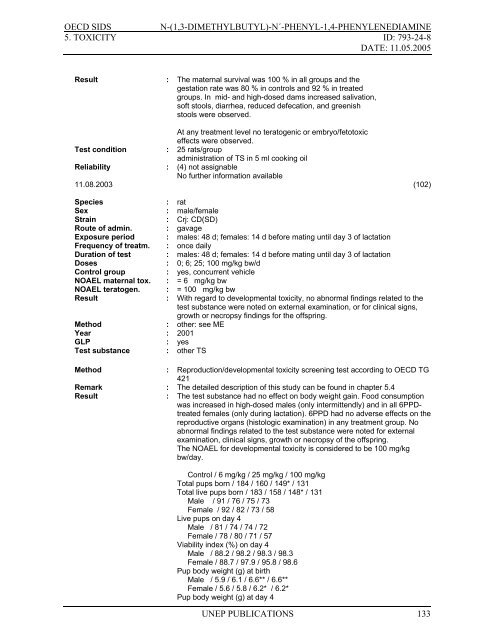N-(1,3-Dimethylbutyl)-N
N-(1,3-Dimethylbutyl)-N
N-(1,3-Dimethylbutyl)-N
You also want an ePaper? Increase the reach of your titles
YUMPU automatically turns print PDFs into web optimized ePapers that Google loves.
OECD SIDS<br />
N-(1,3-DIMETHYLBUTYL)-N´-PHENYL-1,4-PHENYLENEDIAMINE<br />
5. TOXICITY ID: 793-24-8<br />
DATE: 11.05.2005<br />
Result : The maternal survival was 100 % in all groups and the<br />
gestation rate was 80 % in controls and 92 % in treated<br />
groups. In mid- and high-dosed dams increased salivation,<br />
soft stools, diarrhea, reduced defecation, and greenish<br />
stools were observed.<br />
At any treatment level no teratogenic or embryo/fetotoxic<br />
effects were observed.<br />
Test condition : 25 rats/group<br />
administration of TS in 5 ml cooking oil<br />
Reliability : (4) not assignable<br />
No further information available<br />
11.08.2003 (102)<br />
Species : rat<br />
Sex : male/female<br />
Strain : Crj: CD(SD)<br />
Route of admin. : gavage<br />
Exposure period : males: 48 d; females: 14 d before mating until day 3 of lactation<br />
Frequency of treatm. : once daily<br />
Duration of test : males: 48 d; females: 14 d before mating until day 3 of lactation<br />
Doses : 0; 6; 25; 100 mg/kg bw/d<br />
Control group : yes, concurrent vehicle<br />
NOAEL maternal tox. : = 6 mg/kg bw<br />
NOAEL teratogen. : = 100 mg/kg bw<br />
Result : With regard to developmental toxicity, no abnormal findings related to the<br />
test substance were noted on external examination, or for clinical signs,<br />
growth or necropsy findings for the offspring.<br />
Method : other: see ME<br />
Year : 2001<br />
GLP : yes<br />
Test substance : other TS<br />
Method : Reproduction/developmental toxicity screening test according to OECD TG<br />
421<br />
Remark : The detailed description of this study can be found in chapter 5.4<br />
Result : The test substance had no effect on body weight gain. Food consumption<br />
was increased in high-dosed males (only intermittendly) and in all 6PPDtreated<br />
females (only during lactation). 6PPD had no adverse effects on the<br />
reproductive organs (histologic examination) in any treatment group. No<br />
abnormal findings related to the test substance were noted for external<br />
examination, clinical signs, growth or necropsy of the offspring.<br />
The NOAEL for developmental toxicity is considered to be 100 mg/kg<br />
bw/day.<br />
Control / 6 mg/kg / 25 mg/kg / 100 mg/kg<br />
Total pups born / 184 / 160 / 149* / 131<br />
Total live pups born / 183 / 158 / 148* / 131<br />
Male / 91 / 76 / 75 / 73<br />
Female / 92 / 82 / 73 / 58<br />
Live pups on day 4<br />
Male / 81 / 74 / 74 / 72<br />
Female / 78 / 80 / 71 / 57<br />
Viability index (%) on day 4<br />
Male / 88.2 / 98.2 / 98.3 / 98.3<br />
Female / 88.7 / 97.9 / 95.8 / 98.6<br />
Pup body weight (g) at birth<br />
Male / 5.9 / 6.1 / 6.6** / 6.6**<br />
Female / 5.6 / 5.8 / 6.2* / 6.2*<br />
Pup body weight (g) at day 4<br />
UNEP PUBLICATIONS 133
















